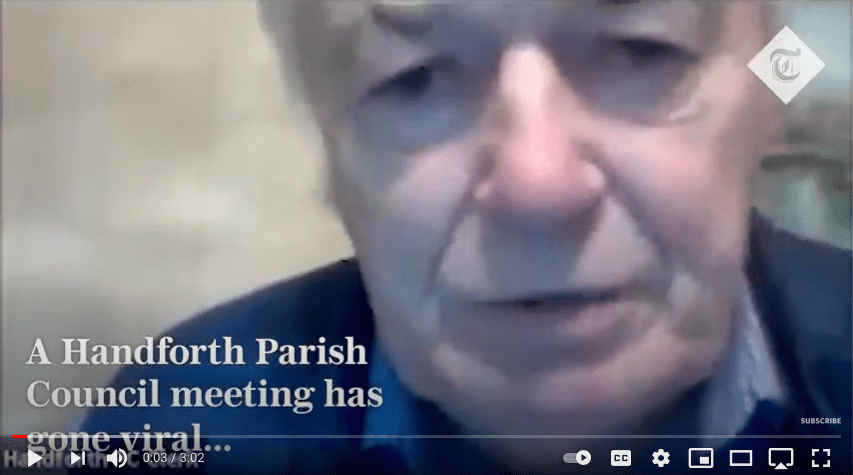Chairing a Meeting Can Conjure up an Image of Parish Councils or Council Committees With Old Fuddy-Duddies Moving at a Slow Pace
But this article deals with modern-day office meetings that happen throughout the week.
Jump to a specific question below:
- What do you say when chairing a meeting?
- How does a chairperson open and close a meeting?
- How do you successfully chair a meeting?
- Meeting problems and how to avoid them
What Do You Say When Chairing a Meeting?
In short, there are some principles you should adhere to, but in the main, you are the chair and you should speak as the leader of that group. You set an example to be followed.

In terms of what you specifically say is around the following principles:
- How to start a meeting: Welcoming and introducing people that are new or do not know each other.
- Sharing the agenda, or inviting items for the agenda.
- Agreeing on the ground rules of how the meeting will be conducted. For example, how the group deals with covid for each other, e.g. social distancing, should that still be a relevant issue.
- Identifying who and how the agreed actions will be taken and when they will be circulated.
- Reiterating the end time of the meeting.
- Conveying the objectives of the meeting.
- How to end a meeting: Reading the agreed actions to check for ambiguity or disagreement, and possibly having an evaluation where you ask each person for one thing that this meeting could have done better.
Many of the above are only used for long, important, or more formal meetings. Usually, the chair of a meeting in an office that is about 5 people, for 1 hour, is more discussion and less formality. The meaning of a chair is to lead the meeting, set an example, and steer the attendees to achieve the objective/s. A confident chair knows what they want to achieve, how they will steer the attendees to doing so, and manages the conflicts carefully.

>> Advanced GROW Coaching Cards <<
>> Access on Amazon <<
How Does a Chairperson Open and Close a Meeting?
Most meetings are informal and in a meeting room with your colleagues, so there is no formal opening, yet you could use the more formal that follows as a basis to begin. Usually reserved for large, important, or more official meetings, this is how I suggest you begin:
Step #1: Start With a Quick Introduction to Make Everyone Feel Comfortable
Begin, or open, a meeting, whether it is face-to-face or online, by introducing yourself, and greeting everyone, and making introductions to those that don’t know each other.

For example:
‘Hello everybody, and thank you for joining. My name is Darren and I have the task of guiding us to achieve our objective today. I suggest everyone takes a few moments to introduce themselves by just saying their name, title, and where they work. Is that ok?’
Be careful because some people will say something like, ‘Oh, I’m not sure. I’ll be quick. My name is John and I work in Engineering over in Building C, and I’m here…’. Then Joh speaks for 2-minutes. Others that follow then believe that they need to do the same. Before you know it one-quarter of the meeting has disappeared in introductions.
My tactic for dealing with this is after John speaks, cut in and say, ‘Thank you, John. We’ll need to pick up speed because I don’t want to keep you later than our agreed time’. This lets the attendees know that if they speak a lot we will be delayed.
Once the introductions are complete, step 2 is to share the subject.
Sticky Learning ® is 7 times more effective than 1-day training courses. Plus, you will get a Chain of Evidence proving your Return on Investment. Discover soft skills training that changes behaviours long term.

Step #2: Sharing the Subject with the Group so that Everyone is on the Same Page and for How Long
For example:
‘Now that everyone knows everyone, our meeting today is about managing the redundancy process effectively and with kindness. Our scheduled time to end is 3 pm. What questions do you have about either why we are here or our end-time?’.
By using an open question (A question that began with ‘what questions…’ you invite more responses than if you used a closed question like ‘Does anyone have any questions about the objective or the time?’. A good chair knows when to use open questions and when to use closed questions.
Step #3: Agreeing How the Meeting will Be Conducted
There are three approaches to how the meeting will be conducted:
- The first is to dive straight into the meeting and deal with items of how the meeting is going, as they arise. For example, people talking over each other – you step-in as the chair, and ask Mike to speak, and then we’ll come to Sarah. As a chair you are a little like traffic lights, encouraging (green light) and stopping (red light) the verbal traffic,
- The second approach is to have a list of rules that you share with the attendees and ask them to adhere to. For example, no talking over each other, end on time, and actions captured & sent by the end of today. It helps to write these on a flipchart or a slide so that the attendees can read them for themselves. Remember that they can read x7 times faster than you can speak, so don’t read your slides – just add highlights. For example, ‘Number 4 is the most important’.
- Brainstorm with the group the ‘ground rules’ or ‘rules of engagement’. Again, these should be captured in a place that everyone can see. You will need to manage the verbal traffic. Encouraging those that do not speak, to do so, and those that are very vocal, to speak a little less. Much of the traffic management can be managed with simple hand gestures, like a police person stopping traffic and waving traffic. It just has to be done very gently.

Step #4: Closing the Meeting Successfully with Agreed Next Steps
There are 3 simple parts to closing a meeting:
- Actions (Also known as the ‘minutes’): The actions can be read out to the group so that everyone is clear on what they are doing next. This is good practice. Just bear in mind that A takes a while to do, and B can resurrect discussions that you thought were closed. Agree on who will send the actions and by when. Ideally, they should be sent on the same day.
- Evaluation: An evaluation is a good practice. Again, be careful how long it takes because some people can be very vocal and want to fundamentally change the structure of meetings everywhere, because meetings for them, are largely unproductive, and this is their platform to speak. My preferred evaluation is a simple one. For example, ‘I’d like to evaluate this meeting, giving everyone 20 seconds to share one thing that they would like improved. Is everyone good with this?’.
- Thank you: A thank you goes a long way. Thanking everyone for their time, attendance, and if the discussions have been tough, then a thank you for everyone’s passion and a reminder that ‘we are all on the same side and fighting for the same thing.
How Do You Successfully Chair a Meeting?
These chairing a meeting 5 tips will help you to have ‘chairing a meeting’ skills and understand what is the role of a chairperson in a meeting and what is involved in being a chairperson:
1. Do Your Preparation
In everyday meetings, this is not always realistic, but let’s say that this is an important meeting with 12 attendees. The cost of the meeting, though not transparent is a lot. You only need 10 people with an average salary of £50k meeting for 1-hour and the cost is hidden, yet expensive, which means that the meeting needs to deliver a return on investment.
Preparation for a chairperson or a facilitator is like a good football referee. You want to ensure that football is play – the meeting keeps moving along – without getting stuck on a topic, or for foul play to stop play – interruptions, mobiles ringing, ‘I must go to another meeting’, etc.
Your preparation must include answering these questions:
- Is the room ready & appropriate, and with the right & working equipment?
- Are the attendees aware of why they are attending and what is expected of them?
- Has the agenda been circulated beforehand to manage expectations?
- What ground rules will you suggest to the group for them to build upon?
- How well do you know how to make the ‘car park’ work? (See below).
- How will you handle potential phones ringing, interruptions, late attendees or early attendees?
- Have you given yourself a buffer, in case discussions are prolonged and you cannot get it all done on the time given?
2. Know What the Group Want to Achieve
Stephen Covey, the author of ‘The 7 Habits of Highly Effective people’ said in Habit #2 – ‘Begin with the end in mind’. In essence, he was sharing with us that if we can look forward into the future to what we want to achieve, then the present is about making every step towards delivering that future. Successful chairmanship is about achieving the objectives. Getting done what everyone wants to get done in that meeting.

The reality is that it is harder said than done. This is because most informal everyday office meetings happen too frequently and the business moves at too much speed, for an objective of the meeting to be agreed upon at every meeting. You may argue that if each meeting had an objective we might achieve more. You’d be right. Meetings have been happening for so long and are such habitual behaviour that we have to be practical about what is possible. And that is to make reasonable changes to the meeting protocol that will make the biggest changes.
Realistically, we could spend a minute or two, at the start of the meeting agreeing with the group on one simple and overriding objective. Accepting that there are many discussions to be had and many smaller objectives to be achieved, yet one common objective would keep the group on track. For example, if the group was meeting to discuss sales performance then the objective of the meeting might be to have 3 new and practical ideas to find new leads. The chairperson should write this onto a flipchart (The power of the pen – Don’t underestimate that whom has the pen and stands next to the flipchart has the power!).
3. Capture the Actions
Of all the elements of a meeting, this is the most important. This is because meetings can become ‘talk shops’ where lots is discussed, yet little is achieved. As someone once said, ‘Meetings are where the hours are lost and the minutes nowhere to be seen’. I believe that it can be the case that people/attendees do not want productive meetings because productive meetings mean that actions happen, and they are busy enough. This can be a cynical view and we’ll need to assume a level of whilst people are busy they do want things to move forward, we just need to bear in mind that there is a subconscious dislike of meetings for this reason.
If you are chairing/facilitating the meeting either capture the actions on a flipchart for everyone to see, or ask someone to have a laptop open and type them straight into a draft email. The best format for actions is a simple one:
- <Who> <What> <When>
- Michael…Create the presentation for client ABC and send to Sue…01-07.
Clear Actions are Key
Whilst this looks easy, it rarely happens and if it does happen the actions are rarely captured well. We only need 3 pieces for an action to be clear and simple:
- Who is going to do the action. Not multiple people because one will always say, ‘I thought Mark was doing it’. Don’t give them any reason not to do it.
- What is that person going to do. Despite the enthusiasm to achieve that action at the time, you will find that Karen’s enthusiasm dies as soon as she leaves the meeting and gets back to her desk. Make the action very clear. No ambiguity or wriggle-room. No reason to say, ‘I’m not sure what they meant, so I couldn’t do it’.
- When will the person get the action competed by. The key here is clarity. A date. It is that simple. If they say ‘next week’, seek clarity – ‘Do you mean by Thursday the 24th?’.
Number the actions because at the start of the next meeting the first item should be ‘Previous Actions’, and so, ‘Starting with number 1 – Michael – completed?’.
The actions should be sent within 24 hours. I’d go one further and say that the actions should be at the attendees’ inbox by the time they get back to their desks. No room for wriggling – ‘I didn’t get the actions until 2 days later’.
4. Keeping the Ball in Play by Using a ‘Car Park’

The ‘Car Park’ is simply a flipchart page titled ‘Car Park’. If the discussion is not relevant, dragging-on, or not productive, the item gets written onto the car park and is addressed later in the meeting, when appropriate. Your commitment to the group is that items are never lost in to the car park and all of them will be revisited by the end of the meeting. If you do not deliver on your promise the attendees will start to think the car park is just a place to put stuff that you don’t like as a means to shut them up. Your trust will be lost.
5. ‘Everyone Shall Be Heard’
You’ll have seen American courtroom dramas where the usher begins the court with ‘Anyone that has business with this court, please come forward and you shall be heard’. A good chairperson is like a traffic light system, giving the red light to those that talk too much, and the green light to those that do not. Balancing the conversation across the room to ensure that not only the loudest ideas are heard, but the mouse-like person in the corner who has a great idea but no influence, is also heard because their idea is probably the better one.
It is worth watching the 3-minute video of the Parish meeting that went horribly wrong – click on the image below:

Meeting Problems and How to Avoid Them, and Use Meeting Solutions Instead – Chairing Tips and Meeting Tips
The meeting problems below can in some cases be managed and solved by the chair and in other cases they need to be solved by the attendees, with the guidance of a good chairperson:
1. Problem: The Chairperson Lacks Confidence.
Solution: Either replace the chairperson & appoint someone else, or postpone the meeting until the chairperson has prepared better – Preparation normally gives confidence.
2. Problem: Death by Powerpoint.
Solution: Ban PowerPoint and use our method.
3. Problem: One Person Consumes the Meeting (They Talk a Lot!).
Solution: A chair’s phrase like this works, ‘Mark. You are very passionate about this topic. That is welcome. We also need to hear from everyone because I’m sure you’d appreciate their perspective too, wouldn’t you?’ (Closed question because you are seeking agreement and not discussion).
4. Problem: ‘I Thought He Was Doing That’ – No one has Done the Action.
Solution: Make sure that only one person is assigned to each action. Plus, make sure the deadline is specific and the what is very clear.
5. Problem: The Meeting Starts Late.
Solution: The chairperson can deal with late arrivals in a number of ways. My recommendation is that for the first 1-2 times the person is ‘let off’. For the third time, you speak directly to that person after the meeting and explain why it is unacceptable that 6 other people wait for one person. And if it happens a third time, that they will not be allowed to attend.
6. Problem: The Meeting Overruns.
Solution: Chairs tend to get a poor reputation if the meeting always overruns. Overrunning either happens because not enough time was allowed for the topic, or a few people spoke excessively. You need to decide which for next time and deal with accordingly.
For a meeting that looks like it will overrun, you share a chair’s phrase, like ‘We have 20-minutes to go and I am doubtful that we will solve these issues in the remaining time. Let’s decide now whether we reschedule a second meeting or accept that wherever we get in 20-minutes is the best solution we can achieve. Which option do you prefer?’.

7. Problem: Actions Not Completed.
Solution: As a chairperson and a leader you have to decide on your stance regarding actions that are not completed. Hold people to task, or let them off? The situation should lead to which option you take. For example, if the actions are critical, or not. Yet be careful not to treat people differently.
8. Problem: ‘It’s a Talk Shop’.
Solution: This phrase is used by many for meetings when they believe that very little is achieved. As the chair, you can change this by everyone agreeing on a worthwhile objective before the meeting begins. You might say, ‘So, we are agreed that if we achieve this objective written on the flipchart within 2-hours, then it will have been a good use of time. Agreed?’.
9. Problem: Actions are Getting Done But the Group is Not Making Progress.
Solution: Sometimes a group meets weekly, but the check-in on actions each week achieves very little progress. The solution is to have more meetings. Yes, more meetings. No one likes more meetings. Consider this story about the snow and the trees because it will help explain why, sometimes, more meetings, work.
10. Problem: Dealing With Difficult People.
Solution: Your options are; use the ‘car park’ explained above, postpone the meeting, take a break, invite the rest of the group to share their opinion, or because people want to know that they are heard, you as the chair can paraphrase. For example, ‘I hear what you are saying Paul – the project will falter unless we involve the stakeholders immediately. Is that what you are saying?’.




